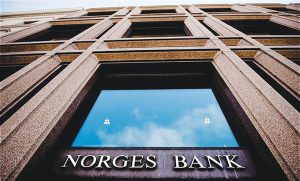Norway’s central bank slowed the pace of interest-rate increases amid signs the economy is cooling, delivering a move forecast by just half the economists surveyed.
Norges Bank lifted its key deposit rate on Thursday by 25 basis points to 2.5%, the smallest increase in its benchmark rate since June. The hike brings the rate to its highest level since 2009, with policymakers saying it will “most likely be raised further in December.†They didn’t give clues on the size of the next hike.
The move suggests Norges Bank again becomes one of the central banks charting a new direction for monetary policy, after it was first among major economies to start raising rates in September 2021. Thursday’s step had split the economists, with an equal number of forecasters expecting the bank would continue a string of half-point hikes to stem inflation that’s at a 34-year high.
The krone falls by as much as 0.8% to a one-week low of 10.3710 per euro after the rate decision. It shortly pared the move to trade at 10.3375 per euro as of 10:55 am in Oslo.
“As such, the September meeting marked a shift toward more moderate rate hikes going forward and a central bank that will use the time to assess the effects of the hikes already delivered,†Nordea’s economists Dane Cekov and Kjetil Olsen said in a note to clients. The news is “to the dovish side to markets expectations,†they said, adding that Norges Bank is likely to hike by a quarter point in December.
The Norwegian decision follows a fourth straight 75 basis-point hike by Federal Reserve. Sweden may opt for a bigger increase later this month than the 50 basis points signaled by Riksbank so far.
Norway’s policymakers have faced a tough trade-off, being wrong-footed by surging inflation like their peers, while the oil producer’s economy is seen shrinking next year, in line with its Nordic neighbours.
Governor Ida Wolden Bache has stressed unusually uncertain outlook with bigger-than-expected slumps in housing and in spending by households among the potential risks.
—Bloomberg
 The Gulf Time Newspaper One of the finest business newspapers in the UAE brought to you by our professional writers and editors.
The Gulf Time Newspaper One of the finest business newspapers in the UAE brought to you by our professional writers and editors.
